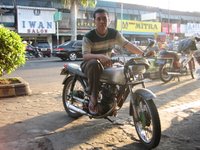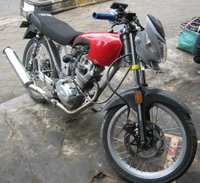Soichiro Honda
From Wikipedia, the free encyclopedia
Soichiro Honda (Honda Soichiro, November 17, 1906–August 5, 1992) was the founder of the Honda Motors company and was born in Hamamatsu, Shizuoka, Japan.
Honda spent his early childhood helping his father, Gihei, a blacksmith, with his bicycle repair business. At the time his mother, Mika, was a weaver. At 15, without any formal education, Honda arrived in Tokyo to look for work. He obtained an apprenticeship at a garage in 1922, and after some vacillation over his employment, he stayed for six years, working as a car mechanic before returning home to start his own auto repair business in 1928 at the age of 22.
In 1948 Honda began producing motorcycles as president of the Honda Motor Company. Honda turned the company into a billion-dollar multinational that produced the best-selling motorcycles in the world. Honda's excellent engineering and clever marketing resulted in Honda motorcycles out-selling Triumph and Harley-Davidson in their respective home markets. In 1959 Honda Motorcycles opened its first dealership in the United States.
Honda remained president until his retirement in 1973, stayed on as director, and was appointed "supreme adviser" in 1983. His legendary status was such that People magazine placed him on their "25 Most Intriguing People of the Year" list for 1980, dubbing him "the Japanese Henry Ford." In retirement Honda busied himself with work connected with the Honda Foundation. He died in 1992 from liver failure.
A dream
Throughout his life, Soichiro Honda never forgot the day he became a small figure who ran hopelessly after the first motor car he ever saw.
Long before it actually reached Yamahigashi, a small village in Japan's Shizuoka prefecture (now called Tenryu-shi), its own extraordinary noise heralded its imminent arrival. The small boy who heard the rumble was at first astonished, then excited, and finally enthralled, by it.
Later he would describe that moment as one of those life-changing experiences. He was seeing his first car, and as he began to tremble the closer it drew, and the dust cloud of its passage engulfed him, something inside him was triggered off.
"I turned and chase after that car for all I was worth," he said later. "I could not understand how it could move under its own power. And when it had driven past me, without even thinking why I found myself chasing it down the road, as hard as I could run."
He had no chance of catching it, and the experience became a symbol for his life: always he was chasing something that was just beyond his reach. By the time the road was empty and the car long departed, the young boy continued to stand there breathing in its gasoline stench. When he came upon a drop of its precious lifeblood spilled on the dusty track, he dropped to his knees and sniffed the oily stain like a man in a desert smelling water.
Early years
Soichiro Honda was born in Yamahigashi on November 17 1906. His father, Gihei Honda, was the local blacksmith but could turn his hands to most things, including dentistry when the need arose. His mother, Mika, was a weaver.
Honda's subsequent spirit of adventure and determination to explore the development of new technology had its roots in his childhood. The family was not wealthy, but Gihei Honda instilled into his children the ethic of hard work, and a love of mechanical things. Soichiro soon learned how to whet the blades of farm machinery, and how to make his own toys. A nearby rice mill was powered by a small engine, and the noise fascinated him. He would demand daily that his grandfather take him to watch it in action. At school he got the nickname 'black nose weasel', which is less derogatory in Japanese than it sounds in English, because his face was always dirty from helping his father in the forge.
Soichiro Honda's childhood days are full of examples of technical ingenuity, including using a bicycle pedal rubber to forge his family's seal on school reports that were less than promising.
The bicycles had another use: those that his father sold from the shop he subsequently opened helped Honda to hone his engineering skills. As he grew, the dream of the car on the country road acted like a magnetic force, drawing him ever closer towards things mechanical. In 1917 a pilot called Art Smith flew into the Wachiyama military airfield to demonstrate his biplane's aerobatic capabilities. Honda raided the family's petty cash box, 'borrowed' one of his father's bicycles and rode the 20 kilometers to a place he had never before visited. When he got there he soon realized that the price of admission, let alone a flight, was far beyond his meagre means, but after climbing a tree he watched the plane in motion, and that was enough. When Gihei Honda learned what his son had done to get to the airfield, he was more impressed with his initiative, determination and resilience than he was angry with him for taking the money and the bike.
Art Shokai
By 1922 Honda was working in an auto shop in Tokyo called Art Shokai. Initially he had done menial tasks, but more and more he became a trusted mechanic. He worked on the racing car Art Daimler, then the famous machine born from the marriage of a Curtiss aircraft engine and an American Mitchell chassis. The need to make parts for this monster taught him things that would be invaluable later in life.
When Shinichi Sakibahara raced the car for the first time at Tsurumi, and won the Chairman's Trophy, the young man riding alongside as his mechanic was Soichiro Honda. He was 17 years old.
As customers brought in Mercedes, Lincolns and Daimlers for attention, Honda's experience grew in proportion with his ambition. Four years after that first race he started his own Art Shokai auto shop in Hamamatsu. It opened its doors for business on the day that, thousands of miles away on Daytona Beach, Frank Lockhart crashed to his death trying to break the land speed record. April 25, 1928. The American track star and the Japanese kid lived in different worlds but had much in common besides their willingness to take a risk. Lockhart's mechanical genius had set new standards for record car design, and in the years that followed Soichiro Honda's own technological ideas would similarly revolutionize Japan's motorcycle and automobile industries.
Yet Honda himself never sought dominance in his homeland. At a time when nationalism was at its peak, he always saw the bigger picture. "I knew that if I could succeed in the world market," he said, "then automatically it would follow that we led in the Japanese market."
Honda Motor Co. Ltd.
Employees in the Art Shokai shop soon came to understand that sloppy workmanship and poor performance would not be tolerated, but while Honda's tool-hurling antics did not always encourage loyalty, those who stayed recognized his total determination to succeed and to establish an engineering business second to none. And Honda was sufficiently aware of his own managerial shortcomings. Honda Motor Co. Ltd. was established in September 1948, initially to build small capacity motorcycles to get Japanese workers mobile. Honda focused his considerable energies on the engineering side, using all the experience he had painstakingly accumulated, including time out taken to study piston ring design at Hamamatsu tech and subsequent experimentation with a small engine-powered bicycle. He left the running of the company in the hands of Takeo Fujisawa, his most trusted friend, and urged him to look to the long-term. They complemented one another perfectly.
When the first fruits of their partnership hit the streets, it was a 98 cc two-stroke motorcycle appropriately named 'Dream'.
Several times Honda Motor Co. sailed close to the rocks in the years that followed, for both Honda and Fujisawa were gamblers who knew that expansion would only be possible with risk. Growth at one stage was unprecedented, until the purchase of state-or-the-art machinery in the early Fifties led them perilously close to bankruptcy. But Honda was never faint-hearted.
Racing
This section needs an update
Later, when the Juno bike flopped and bankruptcy again beckoned, his reaction was to embark on the Tourist Trophy race program that would eventually make Honda's name as an international motorcycle manufacturer. It took him five years, but by 1959 Hondas were racing on the Isle of Man. Two years later they were the talk of the TT.
In 2000, Honda's management again made clear just how determined it is to win again in F1. The first effort, with the 1.5 liter V12 of 1964, came good just as the small-bore formula was ending. The subsequent three-liter V12 was over-engineered and far too heavy, yet won the Italian GP with John Surtees in 1967. But Honda's next effort brought domination throughout the late Eighties and the early Nineties, until Renault's arrival crossed over with Honda's decision to pull back in 1992.
Now once again Honda expects victories, this time from BAR and Jordan, prior to an all-out championship challenge in 2002. Such uncompromising ambition is a fundamental part of the legacy bequeathed by its founder, who died in Tokyo's Juntendo Hospital on August 5 1991, aged 84 years and eight months. "Racing is in our blood," former president Nobuhiko Kawamoto once admitted.
Soichiro Honda was the prototypical F1 engineer. He was always probing new limits of technology, always seeking better and greater feedback from the men who rode or drove the machines that bore his name. He preached the gospel that ambition was no sin, and that success was the reward for hard work and investment. Honda was the first major manufacturer to understand that motorsport was the perfect crucible in which to develop not just superior machines, but superior engineers, and today every global player in the F1 game rotates its engineers through its motorsport programs.
Last years
Yet there was more than even that to Honda. He and his wife Sachi both held private pilot's licences, he was still skiing, hang-gliding and ballooning at 77, and he was a highly accomplished artist. And he was a man of rare understanding. He had never wanted to follow his father in the smithy or the bicycle shop, and he and Fujisawa made a pact never to force their own sons to join the company.
Today Honda continues to leave honorable footprints in the motorsport sand, for it has been racing ever since that day in 1917 when Soichiro Honda left his own footprints chasing an automobile - and a dream - down a dusty road that had no end.



